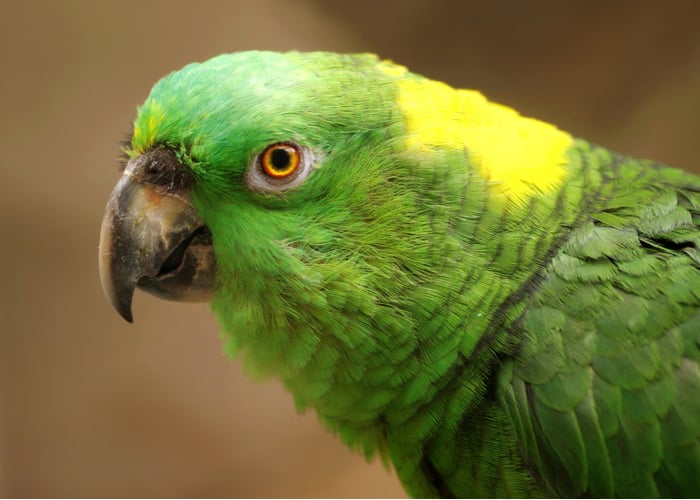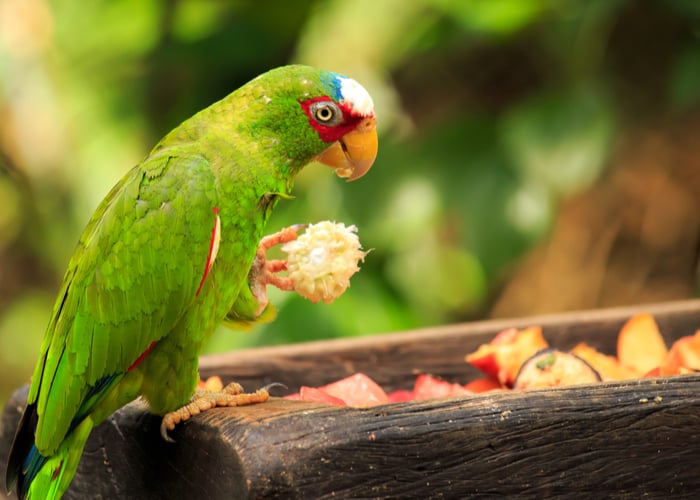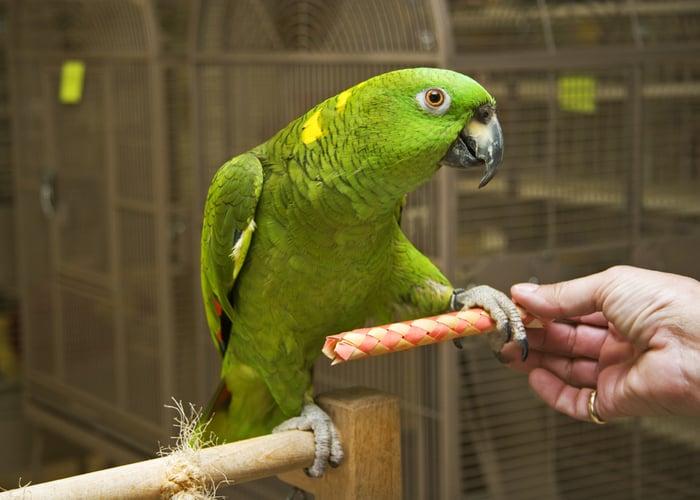Have you ever spotted a lively, medium-sized bird with green feathering and hints of yellow on the wings or head? If yes, you may have already witnessed an Amazon parrot and its simple yet striking beauty.
Amazon birds are rare, but if you’re thinking of adopting one, you came to the right place!
In this guide, we’ll share with you the beauty of these birds and reveal their unglamorous side to help you make wise decisions.
In particular, you’ll learn about an Amazon parrot’s:
- Temperament and behavior towards other birds and their owners
- Diet and common health issues you must be aware of
- Lifespan and how you can keep them healthy and happy
Amazon birds are popular as pets but let’s dig deep to know if they’re worth the hype and how you can raise them successfully!
Amazon Parrot: Species Overview
- Scientific name: Amazona
- Size: 10 to 20 inches
- Weight: 1 to 2 pounds
- Diet: Omnivores
- Wingspan: 8 to 11 inches (depending on the species)
- Talking Abilities: Can talk
- Amazon Parrot Life Expectancy: 30 years or more
- Habitat: Savannas, palm grooves, scrub forests, and rainforests
What is an Amazon Parrot?
The term “Amazon parrot” refers to a variety of medium-sized parrot species with green plumage.
They earned the title “life of the party” due to their playful, outgoing and comical personality. And sometimes, they like to sing and play hard.
These birds can fly at a speed of 40 to 50 miles per hour. They’re sedentary birds, so they don’t migrate or travel far away from home.
There are over 30 Amazon parrot species, but these are the most common pet birds.
Types of Amazon Parrot:
- Blue-fronted Amazon Parrots
- Red-lored Amazon Parrots
- Yellow-naped Amazon Parrots
- Double Yellow Headed Amazon Parrots
- Lilac-crowned Amazon Parrots
- Panama Amazons
- Southern Mealy Amazon Parrots
- Green Cheeked Amazon Parrots
- White Fronted (Spectacled) Amazon Parrots
- Orange-winged Amazon Parrots
Among these birds, the smallest Amazon parrot is the white-fronted species (9.8 in) while Southern Mealy is the largest one (15-16 in).

Amazon Parrot’s Origin and Natural Habitat
As its name suggests, Amazon parrots originate from Amazon Basin in South America, but they can also be found in Mexico and West Indies.
Their natural habitat may vary. These birds can live and thrive in savannas, palm grooves, scrub forests, and tropical rainforests.
Amazon Parrot Temperament and Behavior
These birds are brilliant and enjoy receiving affection and attention from their owners. They are gregarious, playful, and love to entertain their humans using hilarious antics.
Amazon parrot pets are curious and athletic. They typically play hard, so don’t be surprised if they swing upside down and destroy their wooden cage.
They can be comfortable with handling if tamed at a young age. But watch out when your Amazon bird is in distress, unhappy, or overly excited because it may bite you!
It’s best to stop the playtime and calm them down if you notice the following body language that could indicate overexcitement:
- pinning eyes
- fanned tail feathers
- raised head or neck feathers
- broad stance
Are all Amazon parrots loud?
These birds can be loud when vocalizing. It’s their way of communicating with their flock, but it could also indicate danger, anger, excitement, or the need for attention.
Are Amazon parrots aggressive?
Amazon birds can be moody when they reach sexual maturity or the bluffing stage. On top of that, they tend to be aggressive when not trained or handled correctly.
But the good thing is it will pass, but it can sometimes last up to 2 years.
During this period, your Amazon pet bird may bite you and become aggressive towards you.
Males are more likely to develop such aggressive behaviors. So, choose a female Amazon or an older one if you want less fuss.
Amazon Parrot Mating and Reproduction
Amazons are monogamous, like most parrots, and they consistently breed with the same partner.
Pairs stick together even when they join a larger flock during the non-breeding season. Instead of making their nests, they nest in tree cavities or holes.
But how many eggs do amazon parrots lay?
The female Amazons lay two to five eggs, which they then incubate for a month or so. During this period, the males hunt for food and feed the girls.
They’ll also assist in feeding their defenseless chicks. After roughly two months, chicks become fledglings. Biologists don’t know when most parrots reach maturity, but blue-fronted parrots are believed to occur between the ages of two and four.
Amazon Parrot Talking Abilities
“Can Amazon parrots talk?” This may be one of the first questions that would pop into your mind when considering this species as a pet bird option. And yes, they can learn to talk!
Amazon parrots can be excellent talkers, having an average of 100 to 120 words in their vocabulary. They’re chatty, and when appropriately trained, they can speak words and phrases and imitate sounds.
These birds also enjoy listening to music. They’d sing their heart out even if they’re off-key and wouldn’t care about it!
It may be hilarious, but it’s fun witnessing them pour their soul into singing. The downside, however, is Amazon birds can be noisy when they desperately crave attention. They may scream and produce a honk-like sound to get what they want.
Amazon Parrots’ Predators and Threats
In the wild, Amazon parrot chicks and eggs are at risk of hawk, snake, and monkey raids and attacks. They often congregate in large flocks to avoid predators.
But their primary predators are humans.
Humans hunt large parrots for food, while others use their eggs for the pet trade. They also lost a large percentage of their habitat due to deforestation.
Amazon Parrot Conservation Status
Now, let’s talk about how many amazon parrots are left in the world. As of 2021, around 58% of Amazon parrots are considered endangered.
Yellow-naped Amazon parrots’ population was estimated to be around 2,361, while red-tailed amazons in the wild were around 9,000 to 10,000.
On the other end, Imperial Amazon parrots are critically endangered since only about 50 adult birds are in the wild. Red-spectacled amazons from Argentina are also listed as “vulnerable,” while black-billed Amazons are “endangered.”
Furthermore, the IUCN listed Cuban Amazon as near threatened, but the white-fronted Amazon parrot is of “least concern.

Where to Find Amazon Parrot
Do you want to add Amazon parrots to your existing flock? You can find quality Amazon birds from breeders or rescue organizations.
They’re also available in some pet shops, but some are bird mills’ products. Furthermore, they can’t provide complete information regarding the bird’s health, history, and temperament.
So, it’d be better to ask your local avian vets because they can direct you to reputable breeders or rescues. Before committing, ask the seller first about the bird’s:
- daily routine
- diet
- health
- level of tameness
It will help you make wise purchasing decisions.
You may have a wide range of options but make sure to choose an active, alert and healthy bird.
How Much do Amazon Parrots Cost?
Amazon parrot costs can range from $100 to $1,000. The price may vary depending on the bird’s age, species, and quality.
You may also find amazon parrots for adoption from breeders or rescue organizations. But birds that are up for adoption were given up by their owners, so they need a loving home that can take care of them their whole life.
Adoption fees may be less than the purchase price, but the maintenance cost remains the same.

Amazon Parrot Care Tips to Raise Them Successfully
If you decide to raise an Amazon parrot, here’s a guide on how to raise them properly.
Amazon Parrot Diet and Nutrition
Now, we’re down to one of the most crucial parts of raising an Amazon parrot – their diet and nutrition.
What do amazon parrots eat?
These birds have a hearty appetite and love to munch on seeds, nuts, berries, fruits, and vegetables in the wild. But Amazon parrot food in captivity must include pellets, fruits, and vegetables.
These birds tend to graze throughout the day, so you must prepare a day’s worth of pellets in a chew-proof and tip-proof dish. Your bird needs fresh food every day, especially in the morning, so discard uneaten pellets after 24 hours. Spoilt food won’t be good for their health.
And lastly, give them accessible fresh and clean water sources. You may use a water dish or bottle, but if your bird likes to bathe in them, it’d be unsanitary.
So, if possible, and if you’ve trained your birds to drink in a bottle, it’s better to use the latter.
Amazon Parrots’ Hygiene
Most green Amazon parrots enjoy taking a bath either by getting a spray bath, jumping into the water dish, or joining their owner in the shower.
It’s crucial for their feather’s cleanliness and health, so be sure to bathe them at least twice a month.
Cage Size Requirements
Their minimum cage requirement is 2x3x4 feet, but it’s best to purchase the biggest shelter you can afford to ensure they have enough room to fly.
Some owners even create a dedicated aviary for them.
Your birds would love it, too, if you’d provide chew toys, swings, ladders, and perches.
PRO TIP: Put a dye-free paper, paper towel, or any similar material along the bird cage floor so your bird won’t walk in droppings. But if the cage floor is a grate, you have to ensure your bird can still rest on a flat surface.
Amazon Parrot Lifespan
Now, let’s talk about how long amazon parrots live because it’s one of the crucial factors to consider before purchasing one. So, what is the lifespan of an Amazon parrot?
Amazon parrots are long-living birds with an average lifespan of 30 years. Some healthy Amazon parrot pets can even live up to 40 to 70 years.
But it may vary depending on the bird’s species, nutrition, and living conditions.
Diseases could also cut short their lifespan because, like other species, Amazon parrots are also prone to different avian illnesses.
Common Health Issues of Amazon Parrot
Amazon Parrots are generally healthy, but they are susceptible to the following:
Obesity: Amazon parrot’s gluttony makes them prone to obesity, especially when they’re on a high-fat diet.
Feather Picking: Birds may turn to feather plucking due to boredom, lack of stimulation, exercise or activity, sexual frustration, or isolation.
Hypocalcemia: This calcium deficiency often occurs when a parrot’s diet mainly consists of sunflower seeds, peanuts, and nothing or little else.
Atherosclerosis: This disease is common in Amazon parrots, and it causes dyspnea, lethargy, paresis, collapses, and in worse cases, sudden death. It could be due to elevated plasma cholesterol levels, social stress, inactivity, or an unhealthy diet.
Chlamydiosis: “Parrot fever” is a common infectious disease brought by the bacterium Chlamydia psittaci. It causes loss of appetite and weight, lethargy, nasal discharges, shivering, and breathing difficulties in birds.
Foot Necrosis: This syndrome causes the parrot to mutilate the skin on their legs and feet, which leads to excessive bleeding and tissue damage.
Fatty Liver Disease: This condition results from obesity caused by a high-fat diet. Its symptoms include an overgrown beak, black spots, and enlarged fatty liver.
Respiratory Diseases: The most common cause of this illness are vitamin A deficiency, parasites, tumors, fungi, and Chlamydophila bacteria.
Discolored Feathers: It could be due to liver disease or vitamin A deficiency.
Home Injuries: These birds may injure themselves when they bump into ceiling fans or play with electrical wires or toxic fumes.

Training Your Amazon Parrot
Most owners use hand-taming to help their feathery companions get used to their new household life.
It takes time for birds to adjust to a new environment so let your green Amazon parrot settle for a few days after bringing him home.
Then, try to sit beside it and talk to it. It’ll help your bird become comfortable with your presence.
To get the parrot to come to you, start offering snacks through the cage’s bars. Once the bird gets comfortable with this, hold a perch in front of its stomach and instruct it to “step up.”
You can hold a reward in front of the perch and gently press it into the bird’s stomach to urge it to step up. Hold the perch steadily at all times, pausing training sessions if your bird exhibits signs of stress.
If your Amazon parrot climbs successfully, repeat the instruction “step up” while holding your palm in front of the bird’s stomach.
PRO TIP: Make handling enjoyable by providing rewards and compliments. Your bird will love that.
Frequently Asked Questions About The Amazon Parrot
Are Amazon parrots good pets?
Amazon parrots are good family pets. These playful and sweet feathery companions enjoy interacting with their humans. They’re also gentle and affectionate due to their friendly nature.
But Amazon Parrots as pets are active, so they need owners that can keep up with them.
Is it hard to take care of an Amazon parrot?
These birds need consistent attention, a varied diet, adequate exercise, and training to thrive in captivity. So, if you don’t have much time for these birds, they’re not suitable for you.
How do you know if an Amazon parrot likes you?
If your bird is chewing on your hair, ears, beard, and shirt, that’s a sign that he likes you. And when he flaps his tail when you enter the room or his wings while staying in one place, that indicates that he’s happy you’re around.
How often do Amazon Parrots bathe?
Amazon parrots need to take a bath at least every two weeks to keep themselves clean and tidy.
But if they’re noticeably dirty, it’d be best to bathe them at least once a week to clean their feathers and skin.
Do Amazon parrots scream?
Yes, they scream at a high pitch when they’re happy and frustrated. Screaming and chattering are natural for these boisterous and playful birds, so expect that they can be loud sometimes.
Why do Amazon parrots scream?
Parrots scream and vocalize to communicate with each other. Screaming goes hand in hand with Amazon bird’s talking abilities. They also cry when they’re frightened or alarmed. And birds tend to squeal when bored, lonely, stressed, or sick.
Amazon Parrots — Is It The Right Bird For You?
Amazon Parrot is a social bird with hilarious antics and an affectionate personality. But it takes effort and time to tame this species.
On top of that, it requires long-term commitment and lots of mental stimulation and exercise.
So, if you think you can provide for their mental, emotional, and physical needs and want an intelligent bird with the ability to talk, Amazon Parrots are the right birds for you.
But most of the Amazon parrot species are green, so if you want a highly intellectual bird with bright and colorful plumage, this next bird may be the best feathery companion for you!




Great post! I just got my Amazon parrot a few weeks ago, and I’m so glad I found your site. It’s been a steep learning curve, but I appreciate all the tips and advice. I’m glad to know I’m not the only one who’s experienced some of the challenges you mentioned. Thanks for sharing your knowledge and experience!